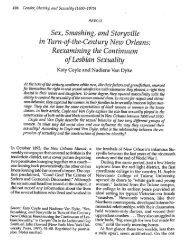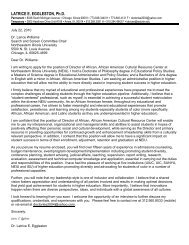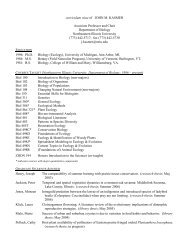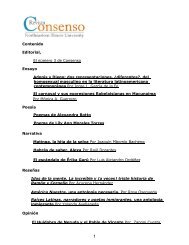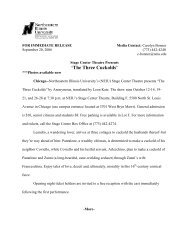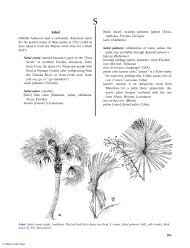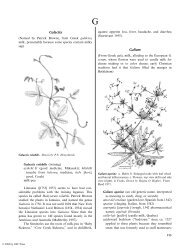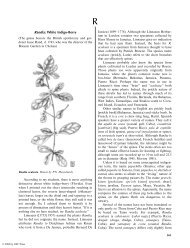GIAN LORENZO BERNINI AND PETER PAUL RUBENS: ON THE ...
GIAN LORENZO BERNINI AND PETER PAUL RUBENS: ON THE ...
GIAN LORENZO BERNINI AND PETER PAUL RUBENS: ON THE ...
You also want an ePaper? Increase the reach of your titles
YUMPU automatically turns print PDFs into web optimized ePapers that Google loves.
nourish'd with juice drawn into them by heat, and thus increase exceedingly both in strength and size; as<br />
appears from the backs of porters, the arms of prize fighters, the legs of dancers, and almost the whole<br />
body of watermen.<br />
2<br />
Gian Lorenzo Bernini in France—from the Diaries of Paul Freart de Chantelo<br />
On Portraiture in Sculpture<br />
Speaking of sculpture and the difficulty of achieving a successful result, and in particular of capturing<br />
a likeness in marble portraits, Bernini told me something remarkable that he has since repeated on several<br />
occasions: that is, that if someone were to whiten his hair, beard, eyebrows and, if possible, the pupils of<br />
his eyes and his lips, and then showed himself in that state, even those who saw him every day would<br />
have difficulty in recognizing him. And as proof of this he added: when a person falls into a faint the<br />
pallor that spreads over his face is alone sufficient to make him almost unrecognizable, so that we often<br />
say, ‘He no longer looks himself.’ For this reason it is very difficult to obtain a likeness in a marble<br />
portrait, which is all of one colour. He told me something else that is even more remarkable: that in a<br />
marble portrait it is sometimes necessary, in order to imitate nature well, to do what is not in nature.<br />
Though this may seem to be a paradox, he explained it in this way: in order to represent the bluish patch<br />
that some people have around the eyes, it is necessary to hollow out the marble at the place where this<br />
bluish colour is, so as to create the effect of the colour and by this artifice to make up, as it were, for the<br />
defect in the art of sculpture, which cannot give colour to things. Thus it is, he said, that nature and<br />
imitation are not the same thing.<br />
His Majesty told Bernini that he would not see him for three days but that in his absence he would be<br />
able to work on the hair of the bust portrait. Bernini replied that he would indeed work on it; he ventured<br />
to say to His Majesty that it was not an easy thing, because he wanted to give to this hair the lightness that<br />
it has in nature; that to do so it was necessary to combat the material, which is of a contrary nature, but<br />
that if His Majesty had seen his Daphne he would know that in that work he had found a satisfactory<br />
solution for the same kind of problem.<br />
M. de Crequi then spoke of the statue of Truth, which is in Bernini's place in Rome, as a work of<br />
perfect beauty. The Cavalier Bernini said that he made it in order to keep it in his house; that the figure of<br />
Time, who carries and reveals Truth, is not finished, and that it is his intention to represent him carrying<br />
her through the air and by the same means to show the effects of time, which finally destroys and<br />
consumes all things. He said that in his model he made columns, obelisks and mausolea, and that these<br />
things, which are shown as overthrown and destroyed by Time, are the very ones that support him in the<br />
air, for without them he couldn't be there, ‘although he has wings’, he said laughing. He added that at the<br />
Roman court there was currently a popular saying, ‘Truth is only to be found at the Cavalier Bernini's….’<br />
On Architecture<br />
The Nuncio remarked that when the Louvre was finished, buildings would be made in the same style.<br />
I replied that this could easily be believed, because the Louvre would then become the fashion. I said that<br />
all that was needed in France was one good example, and that even in Rome it was the remains of<br />
antiquity that served for both sculpture and architecture and continued to provide guidance and assistance<br />
in good practice through many beautiful and great examples. He would not agree with this, saying that the<br />
ancients had never done anything to equal St. Peter's. ‘If you mean mere grandeur of size and quantity of<br />
masonry,’ I replied, ‘I will not dispute this. But in grandeur of style St. Peter's is smaller than the Rotonda<br />
[the Pantheon] and inferior in nobility of workmanship, exactitude and diligence. In any event, monsieur,<br />
do you believe that there were no ancient temples in Greece and Italy that equalled St. Peter's in size and<br />
quantity of material?’ The Nuncio still maintained that there were none and then called the Cavalier<br />
Bernini to ask him if it were not true that St. Peter's was built in a more noble and more excellent style<br />
than the Pantheon. Bernini candidly replied no, that the most perfect forms are circles, squares, hexagons,




